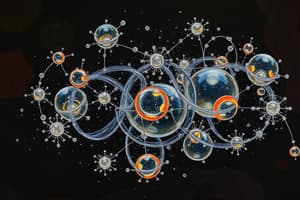Podcast
Questions and Answers
Which state of matter is characterized by having a definite shape and volume?
Which state of matter is characterized by having a definite shape and volume?
- Solid (correct)
- Plasma
- Liquid
- Gas
What is the measure of the total energy of a thermodynamic system?
What is the measure of the total energy of a thermodynamic system?
- Entropy
- Internal energy
- Gibbs free energy
- Enthalpy (correct)
What is the change of state caused by an increase in enthalpy?
What is the change of state caused by an increase in enthalpy?
- Condensation
- Vaporization (correct)
- Sublimation
- Melting
What is the fundamental unit of matter?
What is the fundamental unit of matter?
Which of the following is NOT a fundamental property determined by an atom's structure?
Which of the following is NOT a fundamental property determined by an atom's structure?
Which of the following is NOT a property of an atom's electronic structure?
Which of the following is NOT a property of an atom's electronic structure?
Which of the following elements is NOT an isotope?
Which of the following elements is NOT an isotope?
Which of the following is NOT a mode of resonance for single electron systems?
Which of the following is NOT a mode of resonance for single electron systems?
Which scientist was the first to arrange the chemical elements in order of atomic weights?
Which scientist was the first to arrange the chemical elements in order of atomic weights?
Who formulated the Periodic Law and created his own version of the periodic table of elements?
Who formulated the Periodic Law and created his own version of the periodic table of elements?
Which elements are grouped according to the quantum number and occupied orbitals?
Which elements are grouped according to the quantum number and occupied orbitals?
Which elements readily acquire electrons to become negative ions?
Which elements readily acquire electrons to become negative ions?
Which of the following is NOT a type of bond discussed in the text?
Which of the following is NOT a type of bond discussed in the text?
Which of the following is true about pure elements like H, N, O, F, Cl, Br, I?
Which of the following is true about pure elements like H, N, O, F, Cl, Br, I?
What determines the type of bonds in solid materials?
What determines the type of bonds in solid materials?
Which of the following elements has the highest reactivity?
Which of the following elements has the highest reactivity?
Which type of bonding is responsible for most physical properties of polymers?
Which type of bonding is responsible for most physical properties of polymers?
Which type of bonding has the largest bond energy and high melting temperature?
Which type of bonding has the largest bond energy and high melting temperature?
What is the relationship between bond length and asymmetry of the energy vs. distance curve?
What is the relationship between bond length and asymmetry of the energy vs. distance curve?
What determines a material's chemical, electrical, thermal, and optical properties?
What determines a material's chemical, electrical, thermal, and optical properties?
What type of bonding is responsible for the regular repeating units in crystalline solids?
What type of bonding is responsible for the regular repeating units in crystalline solids?
What type of solid lacks long-range structural order and has restricted atomic or molecular movement?
What type of solid lacks long-range structural order and has restricted atomic or molecular movement?
Which of the following orbitals is spherical in shape?
Which of the following orbitals is spherical in shape?
Which of the following orbitals have two charged elliptical areas/lobes oriented along the axis of the xyz coordinate system?
Which of the following orbitals have two charged elliptical areas/lobes oriented along the axis of the xyz coordinate system?
How many charged lobes do d-orbitals have?
How many charged lobes do d-orbitals have?
How many f-orbital shapes exist?
How many f-orbital shapes exist?
Which type of bonding involves the sharing of electrons from hydrogen atoms?
Which type of bonding involves the sharing of electrons from hydrogen atoms?
What type of bonding occurs between cations (+) and anions (-) and requires electron transfer?
What type of bonding occurs between cations (+) and anions (-) and requires electron transfer?
How are ionic bonds formed?
How are ionic bonds formed?
What type of bonding involves the delocalization of electrons to form an 'electron cloud' shared among all atoms?
What type of bonding involves the delocalization of electrons to form an 'electron cloud' shared among all atoms?
Flashcards
Covalent Bonding
Covalent Bonding
A type of chemical bond formed by the sharing of electrons between two or more atoms. This creates a stable, shared electron pair between the atoms.
Ionic Bonding
Ionic Bonding
A type of chemical bond formed between oppositely charged ions. This occurs when one atom gives up one or more electrons to another atom, creating a positive ion (cation) and a negative ion (anion) that are attracted to each other.
Cation
Cation
A positively charged ion, formed when an atom loses one or more electrons.
Anion
Anion
Signup and view all the flashcards
Ionic Bond Energy
Ionic Bond Energy
Signup and view all the flashcards
Periodic Table of Elements
Periodic Table of Elements
Signup and view all the flashcards
Ceramic Materials
Ceramic Materials
Signup and view all the flashcards
Metallic Bonding
Metallic Bonding
Signup and view all the flashcards
Primary Bonds
Primary Bonds
Signup and view all the flashcards
Secondary Bonding (Van der Waals Bonds)
Secondary Bonding (Van der Waals Bonds)
Signup and view all the flashcards
Melting Temperature
Melting Temperature
Signup and view all the flashcards
Coefficient of Thermal Expansion
Coefficient of Thermal Expansion
Signup and view all the flashcards
Bond Length
Bond Length
Signup and view all the flashcards
Bond Strength
Bond Strength
Signup and view all the flashcards
Bond Energy
Bond Energy
Signup and view all the flashcards
Electron Transfer
Electron Transfer
Signup and view all the flashcards
Electronegativity
Electronegativity
Signup and view all the flashcards
Excitation
Excitation
Signup and view all the flashcards
Relaxation
Relaxation
Signup and view all the flashcards
Material Properties
Material Properties
Signup and view all the flashcards
Brittle Material
Brittle Material
Signup and view all the flashcards
Ductile Material
Ductile Material
Signup and view all the flashcards
Malleable Material
Malleable Material
Signup and view all the flashcards
Hardness
Hardness
Signup and view all the flashcards
Thermal Conductivity
Thermal Conductivity
Signup and view all the flashcards
Electrical Conductivity
Electrical Conductivity
Signup and view all the flashcards
Transparency
Transparency
Signup and view all the flashcards
Strength
Strength
Signup and view all the flashcards
Elasticity
Elasticity
Signup and view all the flashcards
Study Notes
Atomic Structure and Bonding
- Covalent bonding involves the sharing of electrons from hydrogen atoms.
- Ionic bonding occurs between cations (+) and anions (-) and requires electron transfer.
- Ionic bonds are formed when one or more electrons are removed from one atom and attached to another, resulting in positive and negative ions that attract each other.
- The energy of ionic bonding is determined by the balance between attractive and repulsive terms.
- The periodic table of elements is a key tool in understanding atomic structure and bonding.
- Ionic bonding is the predominant type of bonding in ceramics such as NaCl, MgO, and CaF2.
- Ceramic materials can have binary compositions like NaCl and CaF2, or complex compositions like calcium sulfate and mica.
- Metallic bonding involves the delocalization of electrons to form an "electron cloud" that is shared among all atoms.
- The properties of electrons in metallic bonding can be described by their energy levels and their ability to conduct electricity.
- Primary bonds are formed through ionic, metallic, or covalent bonding, depending on the electronegativity values of the atoms involved.
- Secondary bonding, also known as van der Waals bonding, arises from attractive forces between dipoles.
- The properties of materials, such as melting temperature and coefficient of thermal expansion, are related to the type and strength of bonding.
Atomic Structure and Bonding
- Covalent bonding involves the sharing of electrons from hydrogen atoms.
- Ionic bonding occurs between cations (+) and anions (-) and requires electron transfer.
- Ionic bonds are formed when one or more electrons are removed from one atom and attached to another, resulting in positive and negative ions that attract each other.
- The energy of an ionic bond is determined by the balance between attractive and repulsive terms.
- The Periodic Table of Elements shows the arrangement of elements based on their atomic structure.
- Ionic bonding is the predominant bonding in ceramics such as NaCl, MgO, and CaF2.
- Ceramic materials are composed of metals and non-metals, with examples including NaCl, CsCl, CaF2, and various oxides, carbides, nitrides, and borides.
- Metallic bonds involve electrons delocalized to form an "electron cloud" and are characterized by partially filled energy bands of valence electrons.
- The properties of the electrons in metallic bonds are described by the energy levels and the Pauli exclusion principle.
- Primary bonds, such as ionic, metallic, and covalent bonds, are formed when atoms are close enough for their atomic orbitals to interact.
- Secondary bonding, also known as Van der Waals bonding, arises from attractive forces between dipoles.
- Properties related to bonding include melting temperature (Tm), which is influenced by bond length and bond energy, and the coefficient of thermal expansion (αl), which relates to the change in length of a material with temperature.
Studying That Suits You
Use AI to generate personalized quizzes and flashcards to suit your learning preferences.




